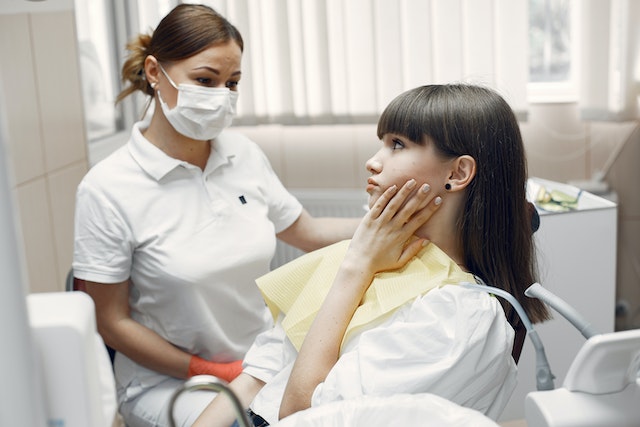
Image Source: Pexels
Dental emergencies can be distressing and require immediate attention. Whether you experience a severe toothache, a broken tooth, or any other dental issue, knowing how to respond can make a significant difference in preserving your oral health. In this comprehensive guide, we will provide you with step-by-step instructions on how to handle common dental emergencies. From managing pain to temporary solutions before seeing a dentist, we’ve got you covered. Let’s dive in!
Identifying Dental Emergencies
Before we delve into the specific steps for different dental emergencies, let’s first understand what constitutes a dental emergency. Some common dental emergencies include:
- Severe toothache
- Chipped or broken tooth
- Dislodged tooth
- Gum abscess
- Bleeding from the mouth
- Injury during a dental procedure
These are just a few examples, and it’s important to note that any situation causing significant pain or discomfort should be treated as a dental emergency. Now, let’s proceed with the step-by-step instructions for handling different dental emergencies.
Severe Toothache
A severe toothache can be excruciating and may indicate an underlying dental problem. To alleviate the pain and manage the situation before seeing a dentist, follow these steps:
- Rinse your mouth with warm saltwater to reduce inflammation and clean the affected area.
- Apply a cold compress or ice pack on the outside of your cheek to numb the area and reduce swelling.
- Avoid placing aspirin or any other pain reliever directly on the tooth or gums, as it may cause burns.
- Contact your dentist immediately to schedule an appointment and discuss the situation.
Remember, a severe toothache should never be ignored, as it could be a sign of an infection or other dental issues that require professional attention.
Chipped or Broken Tooth
A chipped or broken tooth can be both painful and concerning. To manage the situation until you can see a dentist, follow these steps:
- Rinse your mouth with warm water to remove any debris or blood.
- If there is bleeding, apply a piece of clean gauze to the affected area and apply gentle pressure to stop the bleeding.
- If you experience swelling, apply a cold compress or ice pack on the outside of your cheek to reduce it.
- Collect any broken tooth fragments and keep them in a clean container with milk or saliva to preserve them.
- Contact your dentist immediately to schedule an appointment and discuss the situation.
It’s important to note that a chipped or broken tooth should be treated promptly to prevent further damage and potential infection.
Dislodged Tooth
If a tooth has been completely knocked out, immediate action is crucial to increase the chances of saving the tooth. Follow these steps:
- Find the tooth and handle it by the crown (the top part) without touching the root.
- Gently rinse the tooth with milk or saline solution. Avoid using soap or scrubbing the tooth.
- Try to reinsert the tooth into its socket, making sure it faces the right way. Hold it in place by biting down on a clean gauze or cloth.
- If you can’t reinsert the tooth, place it in a clean container filled with milk or the patient’s saliva to keep it moist.
- Contact your dentist immediately or visit an emergency dental clinic for immediate attention.
Remember, time is of the essence when dealing with a dislodged tooth, so act quickly to increase the chances of successful re-implantation.
Gum Abscess
A gum abscess can cause significant discomfort and may require prompt treatment. Follow these steps to manage a gum abscess:
- Rinse your mouth with warm saltwater to help reduce the swelling and relieve pain.
- Gently floss around the affected area to remove any trapped food particles that may be aggravating the abscess.
- Apply a cold compress or ice pack on the outside of your cheek to reduce swelling.
- Take over-the-counter pain medication, following the recommended dosage, to alleviate pain temporarily.
- Contact your dentist immediately to schedule an appointment and discuss the situation.
A gum abscess should not be ignored, as it can lead to further complications if left untreated.
Bleeding from the Mouth
Uncontrolled bleeding from the mouth can be alarming, and immediate steps should be taken to manage it. Follow these guidelines:
- Sit upright or lie back with your head elevated to reduce blood flow to the area.
- Gently rinse your mouth with cold water to remove any blood and identify the source of bleeding.
- Apply gentle pressure with a clean gauze pad or cloth to the bleeding area.
- If bleeding persists or is severe, contact your dentist immediately or visit the nearest emergency room.
- Follow any additional instructions provided by your dentist or medical professional.
Bleeding from the mouth may indicate a variety of dental issues, and it’s important to seek professional help to determine the cause and receive appropriate treatment.
Injury During a Dental Procedure
Injuries during dental procedures are rare but can occur. If you experience an injury or have persistent pain or swelling after a dental procedure, follow these steps:
- Contact your dentist or the dental office where the procedure was performed to discuss the situation.
- Explain the symptoms and any discomfort you are experiencing.
- Follow any specific instructions provided by your dentist or dental surgeon.
- If necessary, schedule a follow-up appointment to have the issue addressed and resolved.
It’s essential to communicate with your dental care provider to ensure proper care and resolution of any complications resulting from a dental procedure.
Preparing for Dental Emergencies
While dental emergencies can occur unexpectedly, it is beneficial to be prepared. Here are some tips to help you be ready for any dental emergency:
- Save your dentist’s contact information in your phone or write it down in a readily accessible location.
- Keep a small emergency dental kit with essential items like gauze, a small container, mouthwash, floss, and salt.
- Familiarize yourself with the location of nearby emergency dental clinics in case your regular dentist is unavailable.
- Stay up-to-date with your regular dental check-ups and cleanings to prevent potential dental emergencies.
- Follow good oral hygiene practices, including regular brushing, flossing, and using mouthwash.
By taking these proactive measures, you can be better prepared to handle dental emergencies and minimize potential complications.
Conclusion
Dental emergencies can be stressful, but knowing how to respond can make a significant difference in preserving your oral health. By following the step-by-step instructions provided in this guide, you’ll be better equipped to handle common dental emergencies. Remember, prompt action and seeking professionals like river north dental is essential in ensuring the best possible outcome. Take care of your oral health, stay prepared, and don’t hesitate to contact your dentist for any dental emergency.


